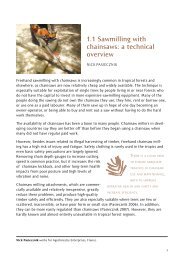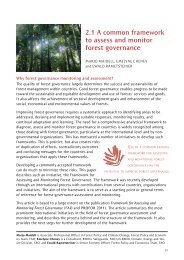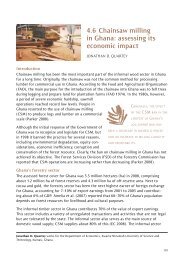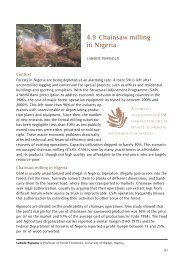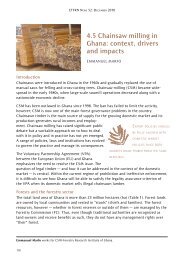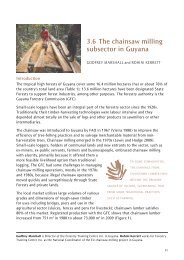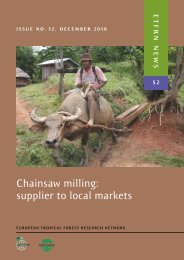Chainsaw milling: supplier to local markets - European Tropical ...
Chainsaw milling: supplier to local markets - European Tropical ...
Chainsaw milling: supplier to local markets - European Tropical ...
Create successful ePaper yourself
Turn your PDF publications into a flip-book with our unique Google optimized e-Paper software.
78<br />
ETFRN NEws 52: DEcEmbER 2010<br />
3.4 Forest communities<br />
and legal timber in the<br />
Ecuadorian amazon<br />
WALTER PALACIOS and ULRICH MALESSA<br />
introduction<br />
Three groups of people inhabit Ecuador’s amazonian ecosystems: indigenous peoples,<br />
settlers and a migra<strong>to</strong>ry population. indigenous peoples are the original inhabitants of<br />
the region and live mostly in vast areas of tropical rainforest. They belong <strong>to</strong> 13 different<br />
nations. Together, indigenous groups and settlers own about 60% of the remaining forest<br />
area (palacios and Freire 2004); 40% is within protected areas (pas). shifting cultivation<br />
has traditionally been practised in harmony with natural forest dynamics. with the<br />
construction of roads and the involvement of indigenous people in the market, however,<br />
the possibilities and need for income have<br />
increased (Fundación natura 2010).<br />
after 1970, more and more settlers began migrating<br />
<strong>to</strong> the amazon, converting the native forest<br />
in<strong>to</strong> pastures and croplands while harvesting wood<br />
for sale. Their farmlands usually cover 40 <strong>to</strong> 50<br />
hectares (kautz 2004).<br />
improved Timber<br />
producTion Techniques<br />
can be inTroduced only<br />
if There is a willingness<br />
To carry ouT collaboraTive foresTry<br />
acTiviTies.<br />
The migra<strong>to</strong>ry population is linked <strong>to</strong> oil exploration<br />
and in many ways is responsible for most of the threats <strong>to</strong> the amazon rainforest.<br />
The opening of the forest by roads, the introduction of substantial economic resources<br />
and the demand for <strong>local</strong> resources have had a severe impact on the forest.<br />
logging and forest conversion are direct threats <strong>to</strong> the amazon forest. unfortunately,<br />
their impact is intensifying, as there is an increasing demand for wood for urban areas and<br />
export.<br />
most production of timber is informal and illegal. in response, the state has improved<br />
forest control with a computerized permit system launched in 2009. The world bank<br />
(2006) has stated that, in order <strong>to</strong> be effective, solutions <strong>to</strong> illegal forest exploitation<br />
caused by poverty must focus on alleviating the precarious economic situation.<br />
walter Palacios is a researcher and professor of forest botany at the Technical university of the north ibarra-<br />
Ecuador and ulrich malessa is Coordina<strong>to</strong>r of the Forest and Timber programme, TraFFiC, Qui<strong>to</strong>, Ecuador.



